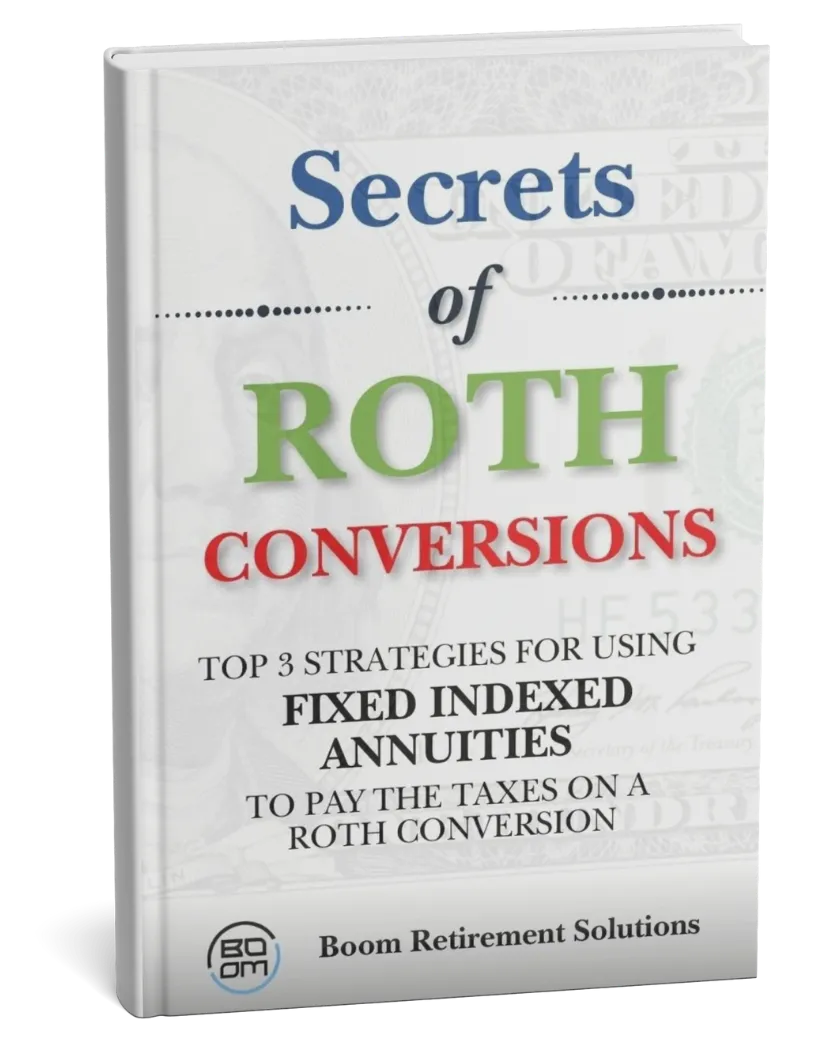
BOOM RETIREMENT SOLUTIONS
Strategies for Boosting Retirement Income

Top Retirement Cash Flow Risks
Why you need this Retirement Toolkit
Will outlive your retirement savings?
Will taxes and inflation erode your Retirement Nest Egg?
Will you head into retirement using an Accumulation Strategy or a Decumulation Strategy?
Will you maintain your lifestyle in a market downturn?
Are you prepared for RMD's and IRMAA?
BOOM RETIREMENT PLANNING
Strategies for Boosting Retirement Income
If You Ask 50 Financial Advisors,
"What is the best way to retire?".
You will get 50 different answers!
That is because despite all their training and certifications,
financial advisors each bring their own perspectives, experiences, and
biases to the table, leading to varied approaches and strategies tailored to their
unique understanding of the market, client needs, and risk tolerance.
Economic Science and Math proves...
There is Only One Optimal Way to Retire
Over 6 Decades of Research Created the 7 Steps Below.
Develop a Plan: Assess your financial situation, retirement goals, income sources and monthly budget for expenses.
Secure Lifetime Income: Consider products like private pensions for guaranteed income.
Maximize Social Security: Optimize benefits by understanding your options; delaying to 67 or 70 can help.
Diversify Investments: Build a balanced portfolio—30% cash value life insurance, 30% lifetime income, 40% growth assets.
Prepare for Health Care Costs: Budget for health expenses, including long-term care, which most seniors will need.
Use Tax-Efficient Strategies: Consider Roth conversions to reduce retirement taxes.
Stay Active and Engaged: Pursue activities for mental, physical, and emotional well-being in retirement.
Our Blog

The Ultimate Guide to Fixed Indexed Annuities: Secure Your Retirement with Guaranteed Income and Market-Linked Growth
The Ultimate Guide to Fixed Indexed Annuities: Secure Your Retirement with Guaranteed Income and Market-Linked Growth
Introduction
In an ever-changing financial landscape, securing a stable, predictable retirement income is a priority for millions. Fixed Indexed Annuities (FIAs) have grown in popularity as they offer a unique blend of market-linked growth potential and protection against market downturns. This comprehensive guide explains what FIAs are, how they work, their benefits and drawbacks, and strategies to effectively integrate them into your retirement plan. Whether you are a seasoned investor or just starting your retirement planning journey, this guide serves as an in-depth resource to help you understand fixed indexed annuities and make informed decisions for your financial future.

What Are Fixed Indexed Annuities?
Definition and Basic Concept
A Fixed Indexed Annuity is a type of annuity contract that offers a guaranteed minimum interest rate combined with the potential for higher returns based on the performance of a specific market index (such as the S&P 500). Unlike variable annuities, FIAs do not directly invest in the stock market; instead, they use formula-based interest crediting methods to link a portion of the returns to market performance while ensuring that your principal remains protected.
How FIAs Work
Premium Payment: You invest a lump sum or series of payments into the annuity.
Interest Crediting: The insurance company credits interest based on a chosen index's performance using a predetermined crediting formula. This might include:
Cap Rates: A maximum limit on the crediting rate.
Participation Rates: The percentage of the index’s gain that will be credited.
Spread/Margin: A fixed percentage deducted from the index gain.
Guaranteed Minimums: Regardless of index performance, many FIAs guarantee a minimum interest, ensuring that your investment does not lose value.
Withdrawal Options: As you approach retirement, FIAs provide methods to convert your annuity into a stream of income, providing financial security during your retirement years.
The Key Benefits of Fixed Indexed Annuities
FIAs combine attractive features that cater to conservative investors looking for safety yet willing to harness potential market gains. Key benefits include:
Guaranteed Income for Life
FIAs are widely recognized for offering guaranteed lifetime income. Many contracts allow you to convert accumulated value into a consistent income stream, reducing the risk of outliving your savings. This is especially beneficial in retirement planning, where a steady income can help mitigate market volatility and inflation risks.
Tax-Deferred Growth
One of the most appealing features of FIAs is the tax-deferred growth on your earnings. This means that income and interest accrued inside the annuity grow without being subject to taxes until withdrawals are made. For many investors, this can result in a larger accumulation of assets over time.
Principal Protection
Unlike direct stock market investments, FIAs typically provide strong protection of your initial principal investment. Even if the linked index performs poorly, you will not lose your original contributions—enabling a more secure long-term investment option.
Market-Linked Growth Potential
While FIAs guarantee a minimum return, they also allow a portion of your funds to participate in gains from a market index. This hybrid nature means you can potentially capture some of the upside of market movements without fully exposing your portfolio to the inherent risks of direct market investments.
Flexibility and Optional Riders
Many FIAs come with customizable options such as death benefit riders, long-term care benefits, or additional income enhancements. These add-ons can further tailor the product to your specific financial needs and legacy planning goals.

Understanding Interest Crediting Methods
FIAs use various methods to determine how interest is credited to your account. A deeper understanding of these methodologies is essential in choosing the right product for your retirement strategy:
Cap Rate
The cap rate is a ceiling on the maximum interest rate that can be credited to your annuity for any given period. While it ensures stability, it can also limit the upside potential in years of high market returns.
Participation Rate
The participation rate determines the percentage of the index’s gain that will be credited to your account. For instance, if the index gains 10% in a year and the participation rate is 80%, your credited interest would be 8%.
Spread or Margin
Some products use a spread, deducting a predetermined percentage from the index's return before crediting interest to your account. This method is another way insurers manage risk and ensure promises regarding minimum returns.
Point-to-Point Method
This approach calculates returns by measuring the performance of the index from the start to the end of a predetermined period. It simplifies the calculation but may not capture all the nuances of index fluctuations throughout the year.
Annual Reset and Multi-Year Smoothing
Certain FIAs offer an annual reset mechanism where gains are locked in at the end of each period. Others may use a smoothing mechanism, which spreads the credited interest over several years for a more stable performance profile.
Evaluating the Pros and Cons of Fixed Indexed Annuities
As with any financial product, FIAs have both advantages and potential drawbacks. Evaluating these can help you determine if they fit into your overall investment strategy.
Pros
Risk Mitigation: Principal protection minimizes the risk of loss, making FIAs a conservative investment choice.
Guaranteed Minimum Returns: Assurance of a minimum interest rate regardless of market performance.
Tax Advantages: Tax-deferred growth supports long-term accumulation.
Lifetime Income Options: Ability to convert the annuity into a steady income stream during retirement.
Customizable Options: Optional riders and flexible features allow for personalized financial planning.
Competitive Market-Linked Returns: Ability to capture a share of market gains without direct exposure to market downturns.
Cons
Complexity: The formulas for calculating credited interest can be complex and may be challenging for some investors to understand fully.
Cap and Participation Limits: While providing safety, these can also limit the maximum potential gains in strong market years.
Surrender Charges: Many FIAs have long surrender periods where early withdrawals may result in penalties.
Inflation Considerations: Even with market participation, some FIAs may not fully offset inflation over long periods.
Fees and Expenses: Administrative costs and optional rider fees may impact overall returns.
Fixed Indexed Annuities vs. Other Annuity Types
To make an informed decision, it is useful to compare FIAs with other popular annuity products such as fixed annuities and variable annuities.
Fixed Annuities
Investment Focus: They offer a guaranteed fixed return.
Risk: Minimal risk with very predictable, steady returns.
Growth Potential: Limited to the fixed rate advertised, with no benefit from market performance.
Best For: Conservative investors who prioritize capital preservation and guaranteed returns over growth.
Variable Annuities
Investment Focus: Returns depend on the performance of underlying investment subaccounts.
Risk: Higher risk due to direct exposure to market fluctuations.
Growth Potential: Potential for significantly higher returns, but with greater volatility.
Best For: Investors willing to accept market risk in pursuit of higher long-term growth, often balanced with investment diversity.
Fixed Indexed Annuities
Investment Focus: A blend of safety, with guaranteed minimum returns, and the opportunity to capture market gains.
Risk: Lower than variable annuities because of the principal protection and market caps.
Growth Potential: Higher than fixed annuities due to market-linked returns, albeit subject to limits.
Best For: Investors seeking stability without completely forgoing the opportunity for growth.
How Do Fixed Indexed Annuities Fit Into a Comprehensive Retirement Strategy?
Integrating FIAs into your retirement planning strategy involves evaluating your overall financial goals, risk tolerance, and income needs. Here are several ways FIAs can complement your retirement portfolio:
Diversification and Safety Net
By including FIAs in your portfolio, you add an extra layer of risk mitigation. They help stabilize your retirement income against market fluctuations while allowing for some degree of exposure to market gains.
Income Planning and Longevity Risk
Many retirees face the risk of outliving their savings. FIAs offer guaranteed lifetime income options that can secure your cash flow over extended retirement years, addressing longevity risk effectively.
Tax-Deferred Growth Benefits
The tax-deferred nature of FIAs means that your investment compounds without immediate tax liabilities. This is a significant advantage as it can result in a larger accumulation of retirement funds over time, especially if you reinvest earnings.
Strategic Risk Management
FIAs allow for a tailored approach to risk management. By choosing products with favorable cap rates, participation rates, and optional riders, you can design an annuity that matches your risk profile while still offering competitive growth potential.
Customization with Riders
Optional riders—such as enhanced income riders, long-term care riders, or death benefits—provide additional layers of customization. These riders can address unforeseen challenges and offer more comprehensive financial planning protection.
Interest Crediting Strategies in Depth
Understanding different interest crediting strategies is vital to maximizing your FIA’s performance. Here we break down the most common methods:
Annual Reset Strategies
Mechanism: At the end of each year, gains are locked in and serve as the new starting point for the following year.
Benefit: Provides clarity and certainty as gains are secured annually.
Limitation: May not fully reflect intra-year market volatility.
Multi-Year Averaging
Mechanism: Compounds returns over several years to smooth out fluctuations.
Benefit: Reduces the impact of short-term market volatility.
Limitation: May delay the recognition of higher returns in booming markets.
Combination Methods
Some FIAs combine elements of annual resets and multi-year averaging, giving you both the advantage of stabilized gains and the possibility to capture higher returns when the market performs well. A thorough review of the crediting method in your chosen product is critical to understanding how your gains will be calculated and credited.
In-Depth Case Study: Comparing Two FIA Models
To further illustrate how fixed indexed annuities work in real-world scenarios, consider the following hypothetical case study comparing two FIA models.
Case Study Overview
Investor Profile:
Age: 55
Retirement Goal: Generate a stable income stream at age 65
Risk Tolerance: Moderate
Principal: $250,000
Product A:
Cap Rate: 6%
Participation Rate: 80%
Crediting Method: Annual Reset
Optional Rider: Guaranteed Lifetime Withdrawal Benefit (GLWB)
Product B:
Cap Rate: 7%
Participation Rate: 70%
Crediting Method: Multi-Year Averaging
Optional Rider: Inflation Protection Rider
Analysis
For Product A, the combination of a strong participation rate and an annual reset model ensures that each year’s gains are securely locked in, providing a predictable growth pattern. The GLWB adds security for lifetime income. For Product B, while the cap rate is marginally higher, a lower participation rate and multi-year averaging may yield slightly less predictable year-by-year returns. However, the inclusion of an inflation protection rider offers enhanced security against rising living costs—making it an attractive option for cost-of-living adjustments over time.
This case study emphasizes the importance of matching FIA features to your financial needs. A detailed consultation with a financial advisor, alongside a careful reading of the product disclosure documents, is always recommended before committing to any FIA product.
Frequently Asked Questions (FAQ) About Fixed Indexed Annuities
What is a Fixed Indexed Annuity?
A fixed indexed annuity is an insurance product that offers a combination of a guaranteed minimum return along with potential market-linked gains, using various interest crediting methods, while protecting your principal investment.
How is my principal protected?
FIAs guarantee that your invested capital will not decrease due to adverse market conditions. Even if the linked index performs poorly, your original contributions remain intact—ensuring a reliable base of funds.
Can I access my money early?
Most FIAs come with surrender periods during which early withdrawals are subject to penalties. It is vital to review the surrender charge schedule before investing.
How does tax deferral work in FIAs?
Any gains accrued within an FIA are not taxed until you make withdrawals. This deferral allows for potential compounding of interest without immediate tax implications, making FIAs attractive for long-term retirement accumulation.
What happens if the market index performs exceptionally well?
Most FIAs have a cap or participation rate that limits how much of the market gain is credited to your account. While you may not capture the full index return, you still benefit from increased crediting rates compared to traditional fixed annuities.
What are the best candidates for fixed indexed annuities?
FIAs are ideal for conservative or moderate investors looking for a blend of safety and market-linked growth, particularly those focused on income planning and principal protection in retirement.
Expert Strategies for Maximizing Your FIA Investment
Integrating FIAs into your broader financial strategy requires thoughtfulness and customized planning. Consider these strategies:
Balance with Other Investments:
FIAs provide a safe harbor within your portfolio. Balancing them with a diversified mix of stocks, bonds, and other vehicles can optimize growth while reducing overall risk.Review Crediting Methods:
Understand whether an annual reset, multi-year averaging, or combination approach best aligns with your risk tolerance and expected market conditions.Optimize Optional Riders:
Riders such as guaranteed lifetime withdrawal benefits or inflation protection can enhance your income stability. Evaluate the cost versus benefit ratio of each rider carefully.Revisit Your Plan Regularly:
As your retirement date approaches or market conditions change, revisiting your FIA and broader portfolio ensures that your strategy remains aligned with your goals.Consult a Financial Planner:
Given the complexity of FIA structures and the interplay of various crediting methods and riders, personalized advice from a seasoned financial advisor can be invaluable in maximizing the benefits of an FIA.
Future Trends and Regulatory Considerations
Innovation in Annuity Products
The financial services industry is continuously innovating to address the evolving needs of retirees. Manufacturers are now exploring more sophisticated index-based strategies, dynamic crediting formulas, and even hybrid products that blend features of FIAs with other investment vehicles.
Regulatory Changes
Regulatory oversight has grown as financial products become more complex. Potential changes in tax laws, consumer protections, or transparency requirements can impact product offerings. Staying informed about regulatory updates is crucial for current and prospective annuity buyers.
Technological Advancements
Enhanced digital platforms now allow easier comparisons of FIA products, clearer illustrations of interest crediting methods, and more straightforward application processes. Leveraging these tools can help you make a better-informed decision when selecting an annuity product.
Conclusion: Is a Fixed Indexed Annuity Right for You?
Fixed Indexed Annuities offer a compelling combination of guaranteed income, tax-deferred growth, and market-linked potential with principal protection. They serve as a critical component in a well-rounded retirement strategy, especially for those who value stability alongside the potential for enhanced returns. By understanding the underlying mechanics, evaluating pros and cons, and integrating customized riders, investors can make an informed decision that aligns with their long-term financial objectives.
Whether you are nearing retirement or planning early for a secure financial future, FIAs provide a flexible and robust option for safeguarding your wealth against market volatility while ensuring that you maintain a steady income stream well into your retirement years.
Final Thoughts
Retirement planning in today’s dynamic economic environment requires both caution and innovation. Fixed Indexed Annuities bridge the gap between the need for safety and the desire for growth. Armed with knowledge about the interest crediting methods, guaranteed income options, and strategic benefits of these products, you can confidently incorporate them into a larger portfolio designed to weather financial storms and capture market opportunities.
By leveraging the insights from this guide and consulting with financial professionals, you can craft a personalized retirement plan that not only meets your needs today but also prepares you for the challenges of tomorrow.
This comprehensive guide is designed to be your go-to resource for everything related to Fixed Indexed Annuities—equipping you with the knowledge to navigate the complexities of the modern retirement landscape. Armed with detailed comparisons, strategic insights, and the latest trends, you are now better prepared to make informed decisions and secure your financial future with confidence.
Taxation can play a substantial role in determining
the overall value of your retirement portfolio
How are your current retirement income sources taxed?
Social Security
Qualified Accounts
Non-Qualified Accounts
Social Security is a federal government program in the United States that provides financial benefits to eligible individuals, primarily retirees, disabled individuals, and their families. It is funded through payroll taxes collected under the Federal Insurance Contributions Act (FICA) and the Self-Employment Contributions Act (SECA).
Key components of Social Security include:
Retirement Benefits: These benefits are available to workers who have paid into the Social Security system through payroll taxes during their working years. Individuals can start receiving reduced retirement benefits as early as age 62, but full benefits are available at the full retirement age, which varies depending on the year of birth. Delaying benefits beyond full retirement age can increase the monthly benefit amount.
Disability Benefits: Social Security Disability Insurance (SSDI) provides benefits to individuals who are unable to work due to a qualifying disability. To be eligible, individuals must have a sufficient work history and meet specific medical criteria.
Survivor Benefits: These benefits are paid to the surviving spouses, children, or dependents of deceased workers who paid into the Social Security system. The amount of the benefit depends on the deceased worker's earnings record.
Supplemental Security Income (SSI): Although administered by the Social Security Administration, SSI is a separate program funded by general tax revenues (not Social Security taxes). It provides financial assistance to elderly, blind, or disabled individuals with limited income and resources.
Social Security is a critical component of retirement planning for many Americans, providing a safety net to ensure a basic level of income in retirement, during periods of disability, or after the death of a family member.
Social Security benefits may be taxed based on your combined income, which includes adjusted gross income, nontaxable interest, and half of your Social Security benefits. Depending on your income level, up to 85% of your benefits could be subject to federal income tax.
A qualified account is a type of retirement savings account that offers tax advantages, typically regulated by the IRS under specific sections of the tax code. Contributions to qualified accounts are often tax-deferred, meaning that contributions are made with pre-tax dollars, reducing the individual's taxable income in the year of the contribution. Taxes on contributions and investment earnings are deferred until withdrawals are made, usually in retirement.
401(k) plans
403(b) plans
457 plans
Traditional IRAs
SEP IRAs
SIMPLE IRAs
Self Directed IRAs
Pensions
Annuities
Withdrawals from these accounts are generally subject to income tax, and there may be penalties for early withdrawals before a certain age (usually 59½). Additionally, qualified accounts are subject to Required Minimum Distributions (RMDs) once the account holder reaches age 73 (if born before 1960).
Required Minimum Distributions (RMDs) are the minimum amounts that retirees must withdraw annually from their tax-deferred retirement accounts, such as traditional IRAs and 401(k)s, starting at age 73 (as of 2023). The amount of the RMD is calculated based on the account balance and the account holder's life expectancy. Failing to take RMDs can result in significant tax penalties, including a hefty excise tax on the amount that should have been withdrawn.
A non-qualified account is a type of investment account that does not have the same tax advantages or restrictions as qualified retirement accounts. Unlike qualified accounts, contributions to non-qualified accounts are made with after-tax dollars, meaning there's no tax deduction for contributions.
Examples of non-qualified accounts include:
Brokerage accounts
Mutual fund accounts
Certificates of deposit
Savings accounts
Roth IRA
Cash Value Life Insurance
Annuities
These accounts are often used for general savings and investments outside of retirement, offering more flexibility in terms of contributions and withdrawals, but without the tax advantages of qualified accounts.
The exception is the Roth IRA in which the principal, interest, earnings and dividends are all tax-free. Roth IRAs are also not subject to RMD's.
A Roth conversion is the process of transferring funds from a Qualified retirement accounts into a Roth IRA (Non-Qualified Account). The converted amount is subject to income tax in the year of the conversion, but future withdrawals from the Roth IRA are tax-free, provided certain conditions are met. This strategy is often used to reduce taxable income in retirement and to avoid required minimum distributions (RMDs).
Books for Retirees and Soon-To-Bes
Choose Your Book
Roth conversions


transitioning


Retirement Income


Tax Strategies




Long Term Care



Boom Final Expense is a brand under Boom Insurance Agency LLC
©Copyright 2023| Boom Insurance Agency. All Right Reserved

Boom Retirement Planning is a brand under Boom Insurance Agency LLC
©Copyright 2024| Boom Insurance Agency. All Right Reserved





